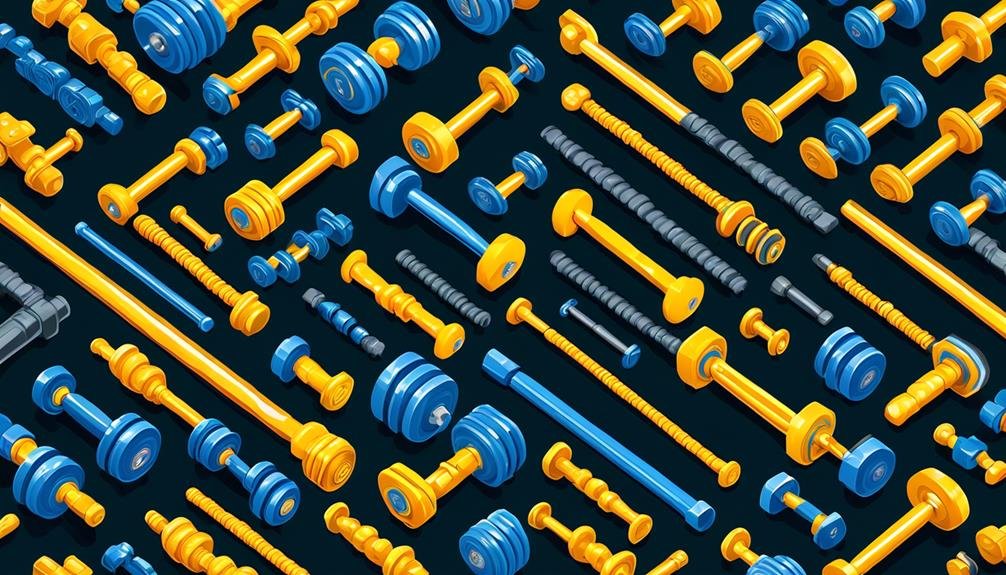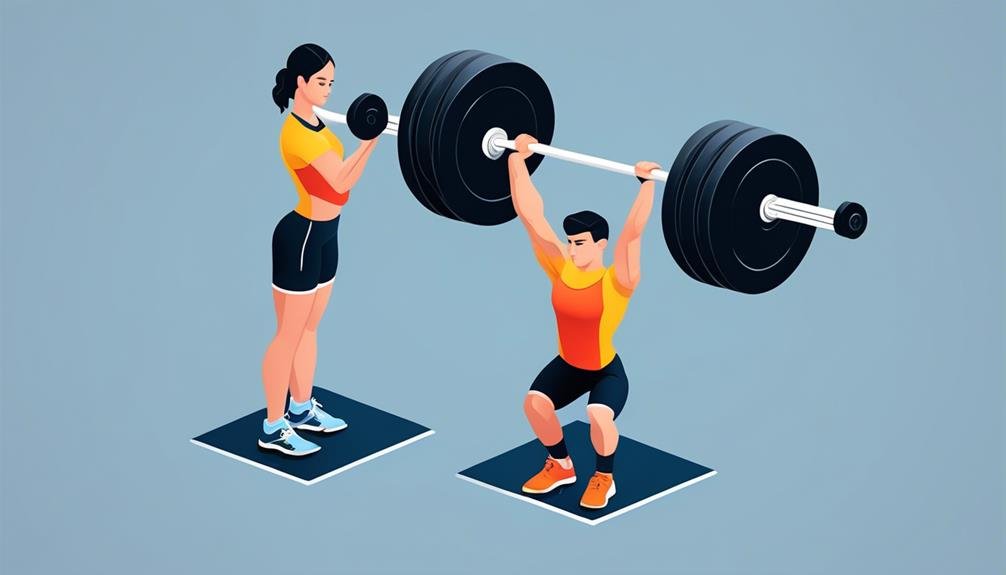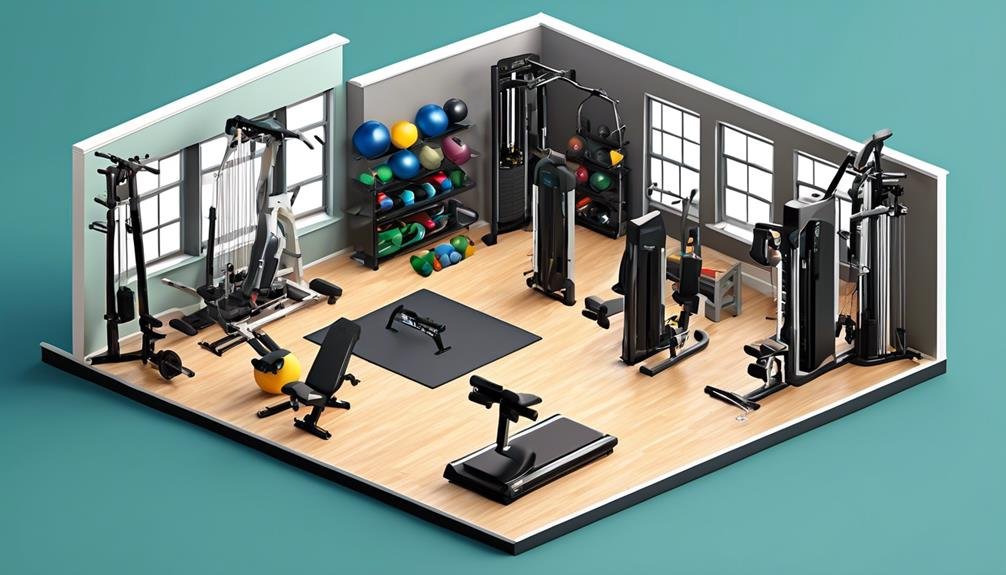Are you a parent wondering what size and type of barbell would be best for your teenager? It's important to consider their age, developmental stage, and individual needs when it comes to weightlifting equipment. With so many options available, it can be overwhelming to find the perfect fit.
But fear not, because in this discussion, we will explore the various factors to consider, such as size and weight guidelines, different barbell types and features, safety considerations, and expert tips for choosing the right equipment.
Stay tuned to discover the keys to ensuring your teenager's success in their weightlifting journey.
Key Takeaways
- Take into account the teenager's age and developmental stage when weightlifting, starting with lighter weights and focusing on proper form and technique.
- Consider body size and structure when choosing a barbell, starting with lighter weights for beginners and gradually increasing, while avoiding overloading joints and muscles.
- Choose between Olympic barbells and standard barbells based on current strength level and training goals, with Olympic barbells being sturdier and more suitable for serious weightlifting pursuits.
- Ensure proper supervision, emphasize proper form and technique, and use proper safety precautions to prevent injury during weightlifting. Implement progressive training and weightlifting programs, gradually increasing weight and repetitions as the teenager becomes stronger.
Age and Developmental Considerations
When considering barbell training for teenagers, it's important to take into account their age and developmental stage. Teenagers go through rapid growth and development, and their bodies are still maturing. This means that they've specific needs and limitations when it comes to weightlifting.
For teenagers who are new to barbell training, it's crucial to start with lighter weights and focus on proper form and technique. This will help prevent injuries and ensure a strong foundation for future progress. As they gain experience and strength, gradually increase the weights, but always emphasize safety and proper form.
It is also important to consider the age and maturity of the teenager. Younger teenagers may not have the same coordination and muscle control as older ones. Therefore, it's essential to provide close supervision and guidance during their training sessions.
Lastly, teenagers shouldn't overdo it with barbell training. Their bodies are still developing, and excessive weightlifting can put unnecessary stress on their muscles, joints, and growth plates. It's recommended to limit their training to a few times a week and allow for rest and recovery days.
Size and Weight Guidelines
To determine the appropriate size and weight guidelines for teenagers in barbell training, consider their current strength and fitness levels. Here are three key factors to keep in mind:
- Body Size and Structure: Teenagers come in all shapes and sizes, so it's important to choose a barbell that suits their body proportions. Look for a bar that allows for a comfortable grip width and accommodates their range of motion during exercises.
- Experience and Skill Level: Beginners should start with lighter weights to develop proper form and technique. Gradually increase the weight as their strength and skill progress. It's crucial to avoid overloading their joints and muscles, which can lead to injury.
- Training Goals: Determine whether your teenager's goal is to build strength, improve overall fitness, or participate in sports-specific training. This will help you select the appropriate weight range for their specific needs.
Barbell Types and Features

Consider the different types of barbells available and their features to find the best option for your teenager's strength training needs.
When it comes to barbell types, there are two main categories to choose from: Olympic barbells and standard barbells.
Olympic barbells are designed for more advanced weightlifting and have a standard weight of 45 pounds for men and 35 pounds for women. They're sturdier, longer, and have rotating sleeves that allow for smoother movements during exercises.
On the other hand, standard barbells are lighter and shorter, making them more suitable for beginners or those focusing on general fitness. They usually weigh around 15 to 25 pounds and are more affordable compared to Olympic barbells.
When selecting a barbell for your teenager, it's important to consider their current strength level and training goals. If they're new to strength training, a standard barbell might be a good starting point. However, if they're more experienced or looking to pursue weightlifting seriously, investing in an Olympic barbell with its added features and durability would be a wise choice.
Safety Considerations and Recommendations
Ensure the safety of your teenager during their strength training sessions by following these important recommendations:
- Proper supervision: Always ensure that your teenager is supervised by a qualified trainer or coach who can provide guidance and instruction on proper form, technique, and safety precautions. This will help prevent injury and ensure that your teenager is using the barbell correctly.
- Start with lighter weights: It's crucial to begin with lighter weights and gradually increase the load as your teenager progresses. This allows their muscles, joints, and connective tissues to adapt and become stronger over time. Starting with weights that are too heavy can increase the risk of injury.
- Use proper form and technique: Emphasize the importance of using proper form and technique when performing exercises with the barbell. This includes maintaining a neutral spine, engaging the core, and avoiding excessive strain on the joints. Proper technique not only maximizes the effectiveness of the exercise but also reduces the risk of injury.
Progressive Training and Weightlifting Programs

As your teenager becomes more comfortable with the barbell and their strength training sessions, it's important to implement progressive training and weightlifting programs to continue their growth and development.
Progressive training involves gradually increasing the intensity and difficulty of their workouts over time. This can be achieved by adding more weight to the barbell or increasing the number of repetitions and sets they perform.
One effective weightlifting program for teenagers is the 5×5 program. This program focuses on compound exercises such as squats, deadlifts, and bench presses. The goal is to perform five sets of five repetitions with heavy weights. This program helps teenagers build overall strength and muscle mass.
Another popular program is the Starting Strength program. This program emphasizes the importance of proper form and technique. It includes exercises like squats, deadlifts, presses, and power cleans. The program starts with light weights and gradually progresses to heavier weights as the teenager becomes stronger.
It's important to note that teenagers should be supervised by a qualified coach or trainer when participating in weightlifting programs. This ensures they're using proper form and technique to prevent injuries.
Expert Tips for Choosing the Right Barbell
To choose the right barbell for your teenager, focus on finding one that suits their specific needs and goals. Here are three expert tips to help you make the right choice:
- Consider the weight and size:
It's important to choose a barbell that's appropriate for your teenager's current strength and abilities. Start with a barbell that's light enough for them to comfortably handle, but still challenging enough to stimulate progress. As they get stronger, you can gradually increase the weight. Additionally, make sure the barbell is the right length and diameter for their hands, ensuring a secure and comfortable grip.
- Quality and durability:
Look for a barbell that's made from high-quality materials, such as stainless steel or chrome-plated steel. These materials are more resistant to rust and corrosion, ensuring the longevity of the barbell. Check for a proper knurling pattern on the barbell, as it provides a secure grip during exercises. Investing in a durable barbell will save you money in the long run and ensure a safer and more enjoyable lifting experience for your teenager.
- Versatility and adaptability:
Opt for a barbell that allows for various exercises and training methods. Look for a barbell with standard Olympic sleeves, as this allows you to easily add weight plates as your teenager progresses. Additionally, consider a barbell with a center knurling, as it provides extra grip for squats. A versatile barbell will enable your teenager to perform a wide range of exercises, targeting different muscle groups and promoting overall strength and fitness.
Frequently Asked Questions
Can My Teenager Start Weightlifting if They Have a Pre-Existing Medical Condition?
If your teenager has a pre-existing medical condition, it's important to consult with their doctor before starting weightlifting. They can provide guidance on whether it is safe and recommend any modifications needed.
Is It Necessary for My Teenager to Use a Specific Type of Barbell for Weightlifting?
You should consider the right size and type of barbell for your teenager when weightlifting. It is important to ensure they have equipment that suits their needs and promotes safe and effective workouts.
How Often Should My Teenager Be Supervised While Weightlifting?
You should supervise your teenager while weightlifting to ensure their safety and proper form. Regular supervision will help prevent injuries and allow you to provide guidance and support during their workouts.
Are There Any Alternative Exercises My Teenager Can Do if They Don't Have Access to a Barbell?
If your teenager doesn't have access to a barbell, there are plenty of alternative exercises they can do. Bodyweight exercises like push-ups, squats, lunges, and planks can help build strength and muscle.
Can My Teenager Continue Weightlifting if They Experience Muscle Soreness or Fatigue?
If your teenager experiences muscle soreness or fatigue while weightlifting, they can still continue by reducing the intensity or taking rest days. It's important to listen to their body and make adjustments accordingly.
Conclusion
So, when it comes to finding the right barbell for your teenager, it's important to consider their age, developmental stage, and training goals. Size and weight guidelines should be followed to ensure safety and proper form.
There are different types of barbells available, each with its own features and benefits.
Lastly, it's crucial to prioritize safety and gradually progress in their weightlifting program.
Keep these expert tips in mind to choose the right barbell for your teenager's fitness journey.





